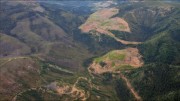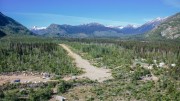Yukon-focused explorer Fireweed Zinc (TSXV: FWZ; US-OTCQB: FWEDF) has rebranded as Fireweed Metals to reflect its metamorphosis into a critical minerals-focused company.
The name change follows its early June acquisition of the Mactung tungsten project in Yukon and the Northwest Territories for $15 million. The project is close to the company’s flagship Macmillan Pass zinc-lead-silver project, where it is mobilizing crews for a $10-million summer drilling program.
Company CEO Brandon Macdonald believes that the Mactung tungsten skarn deposit’s acquisition has transformed Fireweed into one of the leading critical mineral exploration companies.
“We are excited to be advancing both projects under the Fireweed umbrella to maximize value for Fireweed’s stakeholders,” Macdonald told The Northern Miner during a June site visit to the Yukon.
“Our flagship Macmillan Pass project is one of the world’s most significant undeveloped zinc projects. Nearby, our recently acquired Mactung project is one of the world’s largest and highest-grade tungsten deposits. We recently acquired the Gayna River zinc-gallium-germanium project to the north.
“All our projects are in the safe jurisdiction of Canada. With zinc and tungsten designated as critical minerals by Canada, the U.S., and the EU, Fireweed is positioned to be a significant critical minerals player on the world stage and help enable the transition to a sustainable low-carbon economy,” Macdonald said.
The name change took effect on June 30, with trading continuing under the same ticker symbol.
The 37.6-sq-km Mactung property is adjacent to Macmillan Pass and about 13 km north of the company’s Tom deposit. It is accessible by Yukon’s North Canol Highway or by the government-maintained Macmillan Pass airstrip near the Tom site.
It is located within the traditional territories of the Kaska Dena, the Na-Cho Nyäk Dun First Nation in Yukon, and the Sahtú Settlement Area in N.W.T.
About 38,000 metres of drilling across 312 holes since the 1960s have outlined a significant, high-grade tungsten resource, leading to a positive historical feasibility study in 2009.
Historic indicated resources in a 2007 report showed 33 million tonnes grading 0.88% tungsten trioxide with an inferred resource of 11.8 million tonnes grading 0.78%.
“While on its own Mactung is a strong project, we believe there are potential capital and operating synergies that could be gained by developing the projects together,” said Macdonald.
Those include a bulk discount for the mining fleet, reduced costs of a shared camp, admin and possibly mill facilities, and lower costs for shared infrastructure, which translate to reduced engineering costs and improved owner’s cost efficiencies. There are also numerous potential operational benefits to a combined development.
Field crews will be conducting due diligence and validation work at Mactung in the coming months in preparation for the planned mineral resource update and preliminary economic assessment study.
Gaining critical mass
For now, Macdonald says the best value driver for the company is to continue to delineate more mineralization at Macmillan Pass.
Fireweed has recently mobilized field crews to Macmillan Pass to support a four-rig, 8,000-metre diamond drilling campaign.
The program is the most ambitious to date and will also entail core scanning and a muon tomography survey.
According to Macdonald, the program is designed to step out and infill at Boundary zone and Boundary West, with the remaining metres split between Tom and Jason targeting high-grade stepout and infill holes.
All 2022 core, plus core from previous programs and historical core will be scanned using advanced hyperspectral scanning technology.
Jack Milton, the chief geologist at the Macmillan Pass project, said muon detectors would be deployed at Boundary West to effectively target stepouts and help define the geometry of the recently discovered zones of massive and high-grade laminated sulphide.
The Boundary zone remains open in every direction. The 2022 program has been designed step out around the peripheries of Boundary Main and Boundary West, in addition to testing a potential connection between the two zones.
“The stepouts will include testing potential down-dip continuation of the recently discovered high-grade stratiform mineralization at Boundary West and additional massive sulphides in the near-surface area,” Macdonald said.
Three rigs will remain at Boundary Zone, where Fireweed anticipates drilling about 5,800 metres.
The fourth rig will drill Tom West, Tom North, Jason Main, and Jason South, targeting about 2,300 metres between these four large zinc-lead-silver deposits. The holes at Tom West will provide infill data within high-grade zones where the current mineral resource is supported by small-diameter historical diamond drill holes with a feeble recovery in the higher-grade portions of the holes.
Fireweed sees the potential to increase zinc, lead, and silver grades in these areas by drilling large diamet er HQ holes using triple-split tubes to improve recovery, as demonstrated in previous drill programs.
“By the end of the 2022 campaign, Fireweed will have four seasons worth of new drill data that will be used to inform a new global mineral resource. It will include an inaugural resource for the Boundary Main, Boundary West, End Zone and Tom North zones, and an updated resource for Tom West, Tom East, Tom Southeast, Jason Main and Jason South zones,” Macdonald said.
A preliminary economic assessment (PEA) of the project’s Tom and Jason deposits released in May 2018 delivered an after-tax net present value of $448 million and a 24% internal rate of return.
Already robust economics
The early-stage study outlines an 18-year mine life, at least three as an open-pit operation. Starter pits on the Tom West and Jason Main zones lower upfront capital, and the initial capex total of $404 million could be paid back, after tax, in four years.
Over the mine life, an estimated 32.7 million tonnes of mineralization would be mined. At an average processing rate of 4,900 tonnes per day, the project would produce a yearly average of 85,000 tonnes zinc, 48,000 tonnes lead and 2 million oz. silver.
The base case in the PEA employs a zinc price of US$1.21 per lb., a lead price of US98¢ per lb. and a silver price of US$16.80 per ounce. Altogether the Tom and Jason deposits contain 1.6 billion lb. zinc, 610 million lb. lead and 7.7 million oz. silver in the indicated category in 11.2 million tonnes grading 6.59% zinc, 2.48% lead and 21.33 grams silver per tonne. Another 5 billion lb. zinc, 2.7 billion lb. lead and 48.4 million oz. silver lie in the inferred category in 39.5 million tonnes grading 5.84% zinc, 3.14% lead and 38.15 grams silver.
Macdonald believes Fireweed is becoming an increasingly appetizing acquisition candidate for a sizeable base metals company. In recent quarters, diversified Canadian miner Teck Resources (TSX: TECK.B; NYSE: TECK) took a 9% stake in the company.
Macdonald said anecdotal evidence pointed to similarities between Macmillan Pass ore and Teck’s Red Dog mine in Alaska. This combination could potentially offer the company at least some financial and operating savings.
At press time, Fireweed Zinc shares last traded at 60¢ apiece, trending 20% lower over the past 12 months. It has a market capitalization of $55 million.





Be the first to comment on "Site visit: Fireweed Zinc rebrands in pivot to the broader critical metals market"